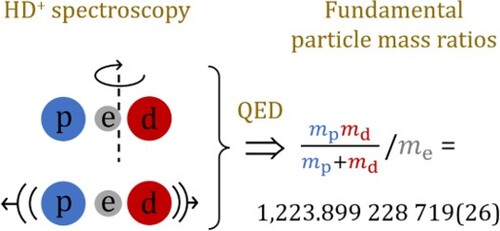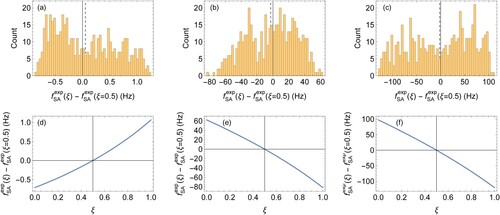Figures & data

Table 1. Theoretical hyperfine coefficients of rovibrational states of involved in high-precision measurements, in kHz. Missing numbers in the first line imply a zero value. The values of
,
(
,
,
) were calculated in Ref. [Citation27] (Ref. [Citation33]). Those of
,
,
, and
are taken from [Citation26]. The value of
has been updated using the latest determination of the deuteron's quadrupole moment [Citation34].
Table 2. Theoretical hyperfine shifts (column 3) and sensitivity coefficients (columns 4-12) for all the levels involved in high-precision measurements. Missing numbers for the state imply a zero value. The uncertainties of the hyperfine shifts are calculated assuming no correlation between
and
for
, which provides an upper bound of the uncertainty.
Table 3. Experimentally determined transition frequencies, (where
and
), of various hyperfine components used in the adjustment of the spin-averaged transition frequencies (Section 4). The alternate labels for the hyperfine components in column 6 are those used in the original references (column 7).
Table 4. Input data for the additive energy corrections to account for the theoretical uncertainties of hyperfine interaction coefficients.
Table 5. Spin-averaged transition frequencies (in kHz). Previous determinations from the original publications [Citation14–16] are given in the first line. The results of the least-squares adjustment performed in the present work are given in line 2. These results were obtained with an expansion factor
(i.e. no expansion factor applied). The spin-averaged frequencies in line 3 are obtained by applying an expansion factor
to the uncertainties of all (experimental and theoretical) input data. Finally, line 4 shows the frequencies for
and including the hyperfine-correlation-induced uncertainty; see text for details. The frequencies on line 4 are our recommended values.
Table 6. Reference theoretical values and sensitivity coefficients of transition frequencies. The theoretical frequencies are calculated using 2018 CODATA values of
,
,
,
,
,
, and α. The sensitivity coefficient for the Rydberg constant
is dimensionless. u stands for the relative atomic mass unit.
Figure 1. Normalised residuals of the 32 input data for the adjustment of spin-averaged transition frequencies. Labels Ai and Bi follow those defined in Tables and .

Table 7. Input data for the adjustments discussed in Section 5. Entries C1 and C5–C7 also serve as reference values in Equations (Equation8(8)
(8) ) and (Equation14
(14)
(14) ).
Table 8. Values of all nonzero correlation coefficients in the input data of Table .
Table 9. Adjustment results. stands for relative uncertainty.
Figure A1. Distribution of correlation-induced shifts of spin-averaged frequencies obtained from a Monte-Carlo simulation consisting of 502 runs. Here the components of the vector are varied together as
; for example,
stands for the vector
(a) Distribution for the
:
transition. (b) Distribution for the
:
transition. (c) Distribution for the
:
transition. Dashed vertical lines indicate the mean value of the frequency distribution. (d) Frequency shift of the
:
transition versus ξ, with all components of the vector
being varied together as
. (e) Same as (d), but for the
:
transition. (f) Same as (d), but for the
:
transition.

